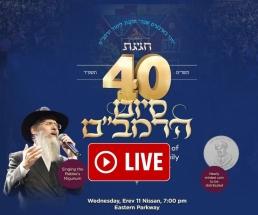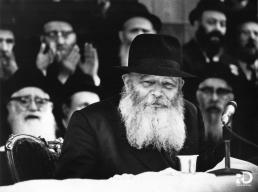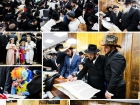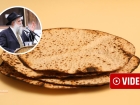The Incredible Story of ‘Bris Avrohom’
It was a frigid day in Communist Russia when ten-year-old Mordechai Kanelsky heard the good news. After seven years of being refuseniks, his family received word that the Soviet government had granted approval for them to leave the country • Full Article
It was a frigid day in Communist Russia when ten-year-old Mordechai Kanelsky heard the good news. After seven years of being refuseniks, his family received word that the Soviet government had granted approval for them to leave the country. The joy they felt that day in 1970 did not diminish the hardship they had endured, or remove the fear they had lived with for years, but it brought a bright light to their dark world and suffused them with hope for a future where they could openly practice their Judaism.
Rabbi Mordechai Kanelsky attributes his family’s success in finally receiving visas to the Lubavitcher Rebbe. Back in 1969, his parents sent a picture of the family to the Rebbe via a cousin in Crown Heights, with a request for a bracha for freedom. When the cousin gave the Rebbe the picture, he took it, put it in a drawer, and said nothing. The next year, before Yom Kippur, his cousin went to visit the Rebbe again. This time, the Rebbe took out the picture, returned it to the cousin, and said he didn’t need it anymore. Three months later, the Kanelskys were free.
At 18, Rabbi Kanelsky decided he wanted to repay the good that was done for him by helping others, and began with a visit to the Rebbe. “I wanted to dedicate my life to helping our less fortunate brothers and sisters who did not get the education we had gotten so that they too could have Yiddishkeit in their lives.” The Rebbe encouraged him and instructed him to call his organization Bris Avrohom, which would be devoted to helping Russian Jews reclaim their Judaism. Upon their marriage, his wife Shterney joined the effort, and together, they have touched and transformed more than 30,000 Jewish lives. But their journeys did not start then. It began many years earlier in Soviet Russia, where, amidst the oppression and fear, they held tight to their faith.
The Kanelskys’ lives in Moscow were fraught with danger and deprivation. The struggle between maintaining a Jewish home and remaining safe from the authorities was constant. Anything Jewish had to remain obscured. Kosher food, Jewish learning, Shabbos candles, and Jewish dress all had to be concealed.
One of the Russian government’s major objectives was to provide everyone with a proper education. Thus, parents were obligated to send their children to a Soviet school. Parents who didn’t were said to be abusing their children. “You could hit your child,” recalls Rabbi Kanelsky, “but you could not not send your child to school.”
When he was eight, Rabbi Kanelsky’s father gave him a choice. His parents could pretend he didn’t live at home and he could learn with a rebbe underground, or he could attend a Russian school. If he chose the former, that meant he would sit in a cellar with his teacher, never seeing the light of day because no one could know he existed. If he chose the latter, he would have to sit all day, every day, without a yarmulke, and every Monday make another excuse for why he hadn’t been to school that Saturday.
The decision was crystal clear to him. He wanted to learn Torah, even if that meant staying indoors, underground in a damp and cold cellar and never having friends. He would live at home, hidden, and continue his family’s tradition of learning Chumash, Gemara, halacha, and Tanya. In the evenings, his grandfather would take him for a short walk in his courtyard so that he could get some fresh air and share the two lines of Tanya he had memorized that day. “I saw the moon, but never the sun,” he remembers.
His father, too, lived with the mesiras nefesh of a Jew devoted to his religion, but burdened by a controlling government. He changed jobs 18 times in order to keep Shabbos. Despite the danger, he kept a beard so that in case he ever got arrested, his son would remember that he remained faithful to his religion.
Rabbi Kanelsky was not the only one who lived courageously, with incredible self-sacrifice, in the former Soviet Union. His wife, Shterney, has her own tales to tell. Born and raised in the city of Samarkand, near today’s Uzbekistan, life was full of challenges. Her parents, Berele and Chaya Esther Zaltzman, were refuseniks for ten years. Twice a year, for ten years, they asked to leave, but the government’s approval was long in coming. When Shterney turned seven, the mandatory age for school, her parents began hiding her so that she wouldn’t be subjected to the Russian school system. For a year and a half they succeeded, until one day government officials surprised them at home and forcefully registered her for school.
In their efforts to keep their children off the radar, her family kept itself removed from the secular community as much as possible. They didn’t participate in social events: they didn’t want people to know how many children they had or to be asked to take part in cultural programs, which mostly took place on weekends. As it was, her father, who worked in an art gallery, had to work on Saturday. “He went to work, but he never worked,” Mrs. Kanelsky remembers. “He walked to his job. When the supervisor passed by to check up on everyone, he made noise, not chas v’shalom, anything to desecrate Shabbos, but noise with the machines so that he looked busy.”
There were many Jews who worked in the gallery with her father. During their lunch break on Shabbos, they would hide in a room and daven as a minyan. It was a miracle that no one ever found them. “They knew they were playing with fire,” she recalls. “If they were caught, they would have certainly been arrested.”
Mrs. Kanelsky’s parents were asked to host an underground yeshiva in their home for boys whose families refused to send them to Soviet schools. The Zaltzmans were also “hiding” their oldest son and agreed to take in fifteen boys. The brunt of the burden fell on her mother who was entrusted with keeping them safe and healthy, in addition to caring for her own six children. If the neighbors found out, the authorities would not take it lightly. “The fear in Russia of raising children with the spirit of Yiddishkeit was unbelievable,” she recollects. “But no matter what, we would not disgrace the Shabbos and Yom Tov.”
A large home and a huge backyard were godsends in making their underground yeshiva possible. A variety of fruit in their backyard helped feed the kids. Everything else had to be made from scratch. Each week, her mother walked 45 minutes to the schochet so he could schecht the one chicken they could afford. Then she had to clean, soak, and salt it. In order to have cholov yisroel milk, she traveled to a farm and watched the farmer milk the cow. Then she had to cook it to make it safe to eat and drink. There was no matzah bakery for Pesach. “When we had matzos shipped from Israel for Yom Tov, the government would deliberately hold on to them and we would first get the package from the post office after Pesach was over,” she remembers. “We kept those matzos for the next year.”
At the far end of the vast backyard was their underground yeshiva. Beneath concealed doors was a moldy, freezing cellar with no windows where the boys learned, sitting with boots, coats, and hats during the winter months. Other than occasional outdoor breaks where they tried to stay as quiet as possible, they sat in that cellar all day.
One day, as the children were playing in the yard they noticed a stranger sitting atop the 16-foot fence surrounding their property. Panic engulfed the family and children; they knew that the consequences could be disastrous. The family’s biggest fear was that the existence of their oldest son would be discovered. The next day, a delegation from the department of education came to search for him.
The Zaltzmans had a clandestine minyan in their home three times a day. Each participant would come at a specific time so as not to elicit any suspicion. The last person was tasked with locking the door behind him. On that very day, the door was left unlocked and the officials barged right in. “I remember how my mother turned white,” says Mrs. Kanelsky. “She knew what it meant and what could result from their visit.” Her mother immediately said her eldest was not home and that he was in Moscow living with her sister. They didn’t call Moscow, but they did insist on searching the home.
“In Russia, all you were taught was to lie. But if you were caught with a lie, that was the end of you,” says Mrs. Kanelsky. They inspected the large house, searching through hanging clothes and opening drawers. To their surprise and to her family’s utter relief, they didn’t find him. If they had realized that, indeed, he had been playing in the backyard (which resembled a forest) with a few friends, the results would have been dire.
Young Shterney was forced to attend the government school. Each Monday she appeared before the teacher and had to provide another excuse why she had been out on Saturday. “As a nine-year-old child, I was very scared. I was taught at home to tell the emes, plus who knew what the teacher would say.” The best excuse was being sick; almost every part of her body “hurt” at one point or another. She and her two sisters were sent to different schools so that no one would realize that the Zaltzman girls had aches and pains every Saturday. “I thank the Ribono Shel Olam that he gave us 248 limbs, so that I could have a different excuse for why I was out each Shabbos for four years.” To help make their stories more believable, her mother would create handmade gifts for the teachers and administrators. But the fear of being reported was never-ending.
These memories are merely the tip of the iceberg. The Kanelskys have enough stories to fill a book. And rather than doing what would have been most expedient, namely, forsaking their religion, they drew from their heritage to sustain them in their darkest times. And that is how they live their lives today.
“All the dictators that tried to diminish the spark of Yiddishkeit did not succeed,” declares Mrs. Kanelsky.
As though to prove it, since its inception in 1979, Bris Avrohom has reached scores of Russian immigrants and their families through their centers in Hillside/Elizabeth, Jersey City, and Fair Lawn. Their state-of-the-art Bat Sheva Chaya Esther Mikvah draws men and women from near and far to immerse in its waters, many for the first time. Adult Jewish education classes are available in three locations throughout New Jersey. The Kanelskys and their associates have performed more than 6,500 brissim, given hundreds of bar mitzvah lessons, and planned countless bar and bat mitzvah celebrations here and in Israel.
Through the direction of the Rebbe, the Kanelskys also began orchestrating gala weddings for immigrants who had not been married under Jewish law. These grand events convene up to 20 couples under 20 chuppahs for a halachic wedding ceremony that is done in high style. Bris Avrohom takes care of Jewish men and women in jail; ensures that Jews don tefillin routinely, and translates Jewish books, including siddurim and Chumashim into Russian. The giant menorahs that can be found throughout the New York/New Jersey area during Chanukah are put there by the Kanelskys. And the list goes on and on.
Each opportunity the Kanelskys have to light the spark of Judaism within their Russian brethren is met with excitement and anticipation. Stay tuned for more incredible stories as the Kanelsky journey continues.
436
Join ChabadInfo's News Roundup and alerts for the HOTTEST Chabad news and updates!










































